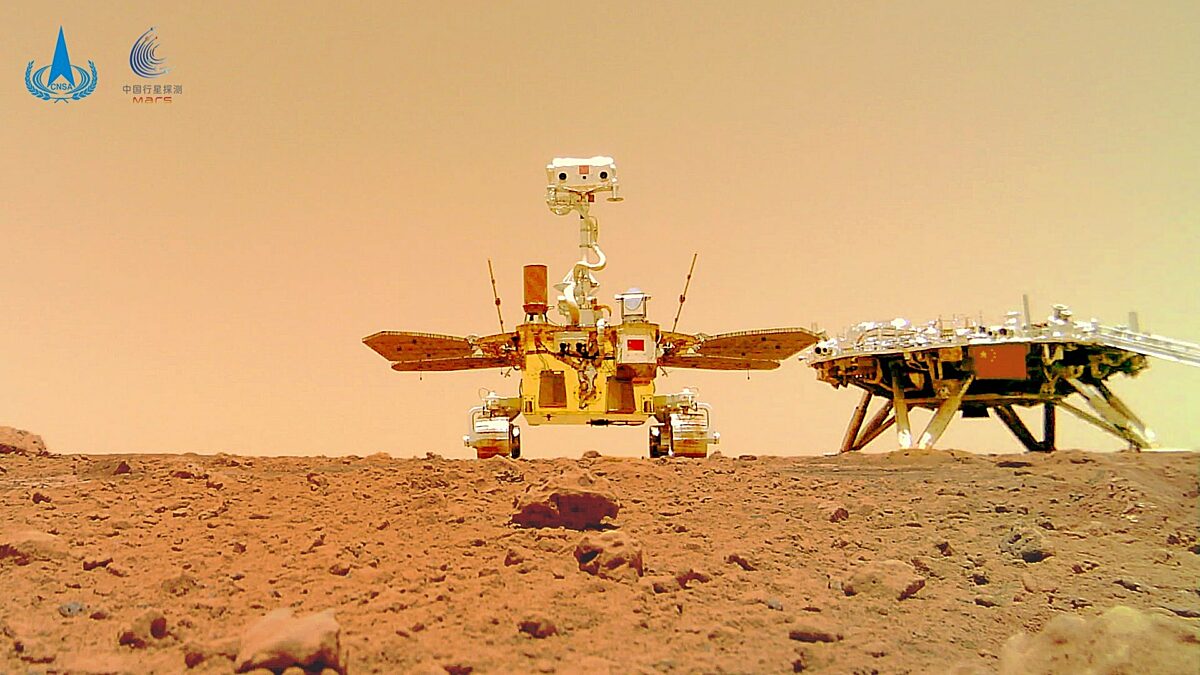Tianwen-1 and Zhurong, China's Mars orbiter and rover
Highlights
- Tianwen-1 ("questions to heaven," or "questioning the heavens") is China's first Mars mission, consisting of an orbiter and a rover named Zhurong. It entered Mars orbit in February 2021 and Zhurong landed on May 14, 2021.
- Among the rover’s science instruments is a radar that could detect pockets of water beneath the surface, which may contain life.
- Zhurong entered a planned sleep in May 2022 and did not wake up in December 2022 as planned. Chinese officials suspect the rover has too much dust on its solar panels to generate power.
What does Tianwen-1 do?
Water doesn’t currently exist on Mars' surface, but it used to. We know this from dramatic dry canyons and river channels seen from orbit, as well as minerals on the surface that only form in liquid water. Around 3 billion years ago, something happened to Mars’ atmosphere, and most of the liquid water evaporated. But some of it may still be underground, safely shielded from harmful solar radiation that bombards the planet’s surface. Could those ancient pockets of water contain life?
China’s Tianwen-1 Mars mission launched on July 23, 2020 amidst the added challenge of the global COVID-19 pandemic. It has, among other things, searched for pockets of water using radar mounted on the Zhurong rover.
Why we need Tianwen-1
Tianwen-1 gives China valuable Mars experience and lays the groundwork for a possible sample return mission planned for the end of the 2020s. Getting Martian samples back to Earth is a top priority for the scientific community. Despite the impressive advances made in placing miniature science instruments on spacecraft, only Earth-bound technology can date samples with absolute precision, reproduce scientific results, and verify the presence or absence of life in a sample.
Before Zhurong only NASA had successfully landed and operated spacecraft on Mars. More countries exploring Mars and our solar system means more discoveries and opportunities for global collaboration. Space exploration brings out the best in us all, and when nations work together everyone wins.
Tianwen means "questions to heaven," or "questioning the heavens." You can listen to a pronunciation of Tianwen by Quanzhi Ye. All interplanetary Chinese missions are expected to carry the Tianwen moniker going forward.

When did Tianwen-1 reach Mars?
Tianwen-1 entered Mars' orbit on February 10, 2021.
As China’s first Mars mission, Tianwen-1 is uniquely ambitious. No nation had ever attempted to send an orbiter and rover to Mars on the first try. But China succeeded, making Tianwen-1 a historic victory.
Tianwen-1 arrived in Mars orbit as a single spacecraft. Once on Mars, the landing platform extended a ramp, allowing the Zhurong rover to roll gently onto the surface—similar to the way China’s Chang’e Moon rovers are deployed.
When did the Zhurong rover land on Mars?
Zhurong successfully landed on the Red Planet on May 14. The rover touched down on Utopia Planitia—the vast Martian plain where NASA’s Viking 2 spacecraft landed in the 1970s, and the site of a shipbuilding yard in the Star Trek universe.
Mars landings are uniquely challenging. They require heat shielding, thrusters, and supersonic parachutes—a teeth-gnashing experience that NASA has dubbed the “7 minutes of terror.”
What capabilities did Zhurong have?
Zhurong could communicate directly with Earth or use its Tianwen-1 orbiter for high-speed data relay. The orbiter has its own set of science instruments for studying Mars, including a high-resolution camera that should produce stunning images.
Zhurong had cameras, instruments for studying Mars’ climate and geology, and even an instrument to zap rocks and record the resulting chemical signatures—just like NASA’s Curiosity and Perseverance rovers. The rover radar worked by shooting radio waves into the surface and measuring reflection times, allowing scientists on Earth to piece together a 3D map of what lies beneath.
China’s Yutu-2 rover used radar on the far side of the Moon to reveal 3 distinct layers extending 40 meters beneath the surface. Scientists tested a rover-sized radar in China’s Qaidim basin—a cold, desert region like Mars—and were able to detect underground water pockets of water. On Earth, these pockets can host thriving microbial communities, so detecting them on Mars would be an important step in our search for life on other worlds.
Zhurong's primary mission was scheduled to last three Earth months. It operated for a year before entering hibernation to ride out the Martian winter in 2022. Images from NASA's Mars Reconnaissance Orbiter published in February 2023 indicate that Zhurong is no longer moving. Chinese officials suspect the rover has too much dust on its solar panels to generate power.
Tianwen-1 enters Mars orbit This video shows China's Tianwen-1 orbiter and rover entering Mars orbit on 10 February 2021. The spacecraft captured the images 3 seconds apart, and the entire video covers a period of 27 minutes.Video: CNSA/PEC via Andrew Jones
Support Missions Like Tianwen-1
Whether it's advocating, teaching, inspiring, or learning, you can do something for space, right now. Let's get to work.


 Explore Worlds
Explore Worlds Find Life
Find Life Defend Earth
Defend Earth


